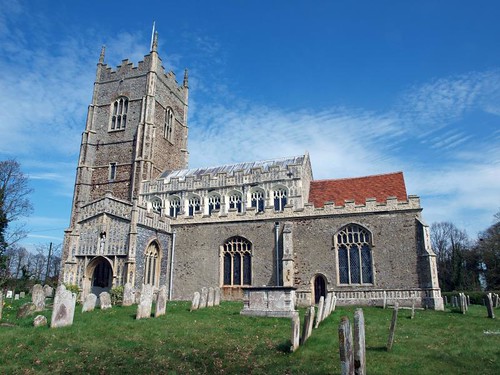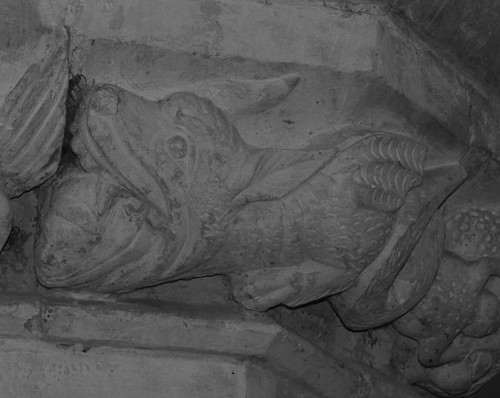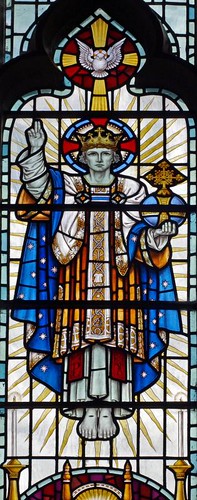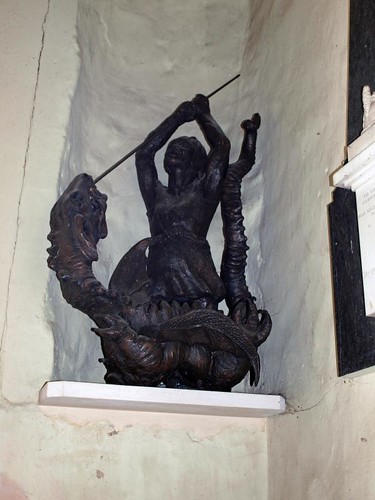My only quibble is that the brass is now inaccessible having been carpeted over - nevertheless wow!
ST GEORGE. A fine sight, proud and compact; entirely in the East Anglian style. Big W tower, tall nave with tall clerestory of closely set windows, short chancel. The W tower is the most spectacular piece. It starts at the base with a quatrefoil frieze, The buttresses are clasping but continue higher up as a combination of diagonal and angle buttresses. W doorway with fleurons in the jambs and voussoirs, hood-mould on an eagle and an angel. Five-light W window with panel tracery, three-light bell-openings with one transome. Stepped battlements and crocketed pinnacles. The S porch is all flushwork-panelled. It has a parapet instead of the more usual battlements. Niche above the doorway, three-light side openings. The S doorway has fleurons in one order and a foliage trail in the other, both in jambs and voussoirs. Above two re-set spandrel figures: Adam and Eve. The S chapel is also singled out as something special - by flushwork panelling at the base. Three-light windows in the aisles, with Perp panel tracery, the patterns different on the S and N sides.* Two-light windows with one transome in the chancel (the E window is C19). The clerestory windows of two-lights are oddly not in line with the arcades below. There are seven windows to three bays. The S arcade is C14, the N arcade C15. Both have octagonal piers, but the proportions differ characteristically. The S piers have capitals generously decorated with leaves. The westernmost instead uses fifigures of angels, lions, a head with tongue out and a dragon and a frog biting him. The nave is covered by one of the most magnificent roofs of Essex, a double-hammerbeam (cf. Castle Hedingham, Gestingthorpe). - S and N DOORS. Both elaborately traceried; c. 1500. - BRASS. William Bischopton d. 1432, figure of a priest, about 3 ft long, under an arch and a gable with concave sides, crocketed and originally pinnacled.
* N doorway minor, yet with three orders of fleurons in jambs and voussoirs.
GREAT
BROMLEY. A pleasant little place in the valley of the Frating Brook, it
has a splendid church showing how wonderfully well the medieval workers
in wood and stone could add beauty to the work of earlier days. The
church is 15th century. The glorious tower with its pinnacles and great
buttresses, and the clerestory with 14 great windows over 14th century
arcades, were built in 1500. The high-pitched double-hammer roof with
its richly moulded beams and curved braces belongs to the same period.
The wall-posts of this lovely roof terminate in canopied niches in which
saints stand on stone corbels carved with angels. The capitals of the
piers in the nave are carved with oak leaves and grotesque beasts, one
swallowing a man and one attacking a woman. There were many brasses on
the stones in the floor but only two remain, one of William Bischopton,
who died in 1432, and the other of John Hubbard, buried in 1537.
Here in our own century has been placed a window by American descendants of Gregory and Simon Stone, who left Great Bromley in 1634 to settle in the new land then growing up to be a New World. The window has a delightful picture of the ship which bore these courageous emigrants across the broad Atlantic, and in its scene is a stately figure of a Red Indian.
Perhaps best of all is the porch through which we come to see all this. It has a lovely doorway and a charming parapet, with big windows and walls of knapped flints in elaborately traceried stone panels; and it is a masterpiece of 15th century building.
Here in our own century has been placed a window by American descendants of Gregory and Simon Stone, who left Great Bromley in 1634 to settle in the new land then growing up to be a New World. The window has a delightful picture of the ship which bore these courageous emigrants across the broad Atlantic, and in its scene is a stately figure of a Red Indian.
Perhaps best of all is the porch through which we come to see all this. It has a lovely doorway and a charming parapet, with big windows and walls of knapped flints in elaborately traceried stone panels; and it is a masterpiece of 15th century building.




No comments:
Post a Comment